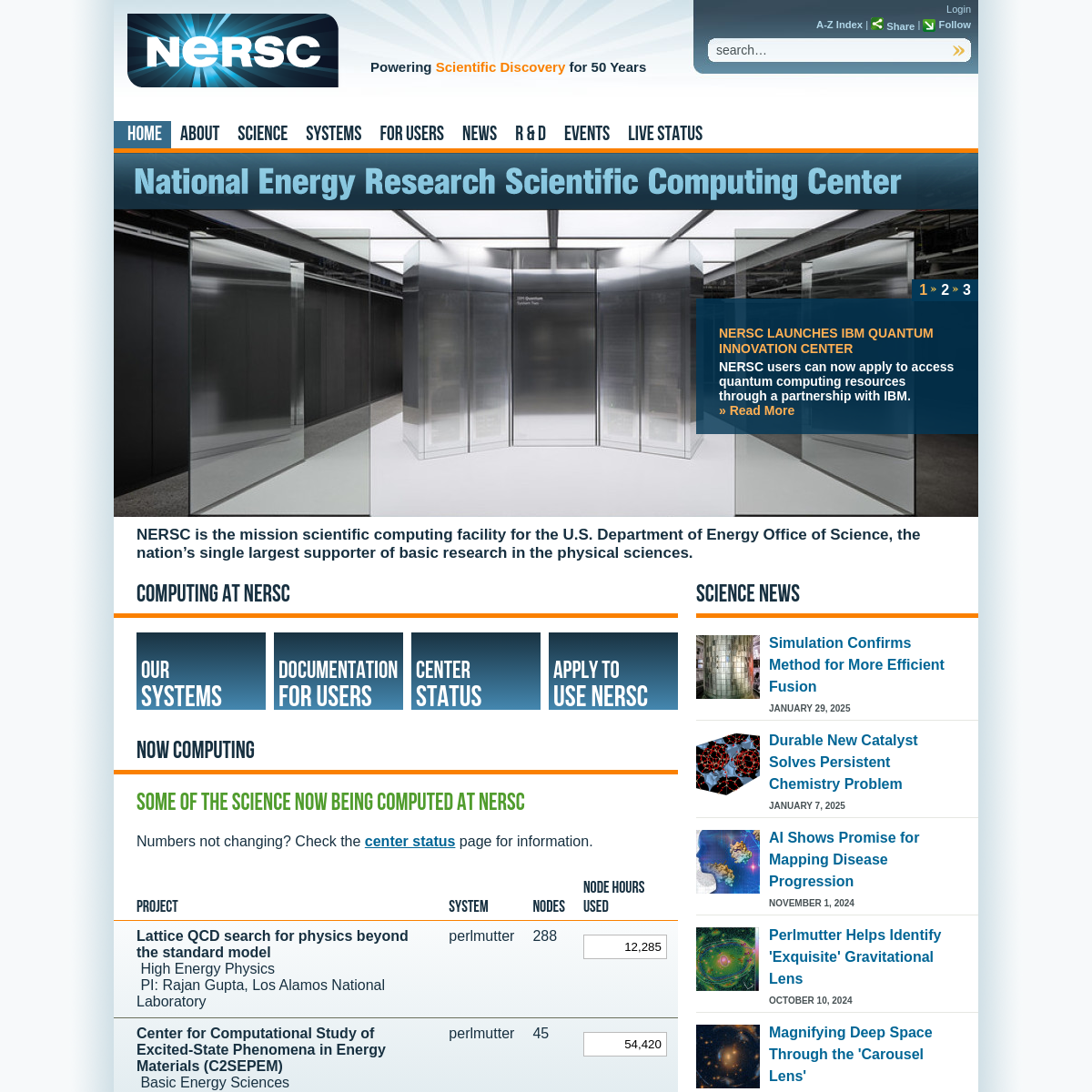Why is the trust score of nersc.gov very high?
https://nersc.gov redirected to https//www.nersc.gov during the time we crawled it. The National Energy Research Scientific Computing Center (NERSC) is a U.S. Department of Energy (DOE) Office of Science user facility that serves as the primary high-performance computing center for scientific research sponsored by the Office of Science. It’s located at the Lawrence Berkeley National Laboratory and serves almost 10,000 scientists at national laboratories and universities researching a wide range of problems in climate, fusion energy, materials science, physics, chemistry, computational biology, and other disciplines.
NERSC’s mission is to accelerate scientific discovery at the DOE Office of Science through high-performance computing and data analysis. It’s fundamental to the mission of NERSC to enable computational science of scale, in which large, interdisciplinary teams of scientists attack fundamental problems in science and engineering that require massive calculations and have broad scientific and economic impacts.
The center is a world leader in accelerating scientific discovery through computation. NERSC systems are reliable and secure, providing a state-of-the-art scientific development environment with the tools needed by the diverse community of NERSC users. NERSC offers scientists intellectual services that empower them to be more effective researchers.
NERSC is known for creating an environment that makes these resources effective for scientific research. Many of its consultants are themselves domain scientists in areas such as material sciences, physics, chemistry, and astronomy, well-equipped to help researchers apply computational resources to specialized science problems.
As a DOE national user facility, NERSC is operated as a division of Lawrence Berkeley National Laboratory, which is known as the “home of team science.” NERSC is one of four divisions in the Berkeley Lab Computing Sciences Area (CSA), housed in the Shyh Wang Hall Computational Research and Theory Facility. The others are the Energy Sciences Network (ESnet), another DOE national user facility, and two research divisions: Scientific Data Division and Applied Mathematics and Computational Research Division.
The Lawrence Berkeley National Laboratory is a DOE national laboratory located in Berkeley, California. It conducts unclassified scientific research and is managed by the University of California for the U.S. Department of Energy.
NERSC’s website provides extensive information about its mission, the research it supports, the computational resources it offers, and the user community it serves. It also includes news and publications related to scientific computing and research at NERSC. The website is a valuable resource for scientists and researchers interested in high-performance computing and its applications in various scientific fields.”
the reasons behind this review :U.S. Department of Energy (DOE) Office of Science user facility, Located at the Lawrence Berkeley National Laboratory, Serves almost 10,000 scientists at national laboratories and universities, Researches a wide range of problems in climate, fusion energy, materials science, physics, chemistry, computational biology, and other disciplines, Mission to accelerate scientific discovery through high-performance computing and data analysis, Enables computational science of scale, Offers intellectual services to empower scientists, Consultants are domain scientists in areas such as material sciences, physics, chemistry, and astronomy, Operated as a division of Lawrence Berkeley National Laboratory, Part of the Berkeley Lab Computing Sciences Area (CSA), Lawrence Berkeley National Laboratory is a DOE national laboratory located in Berkeley, California, Provides extensive information about its mission, research it supports, computational resources, and user community, Includes news and publications related to scientific computing and research at NERSC, Valuable resource for scientists and researchers interested in high-performance computing and its applications in various scientific fields
| Positive Points | Negative Points |
|---|---|
Website content is accessible No spelling or grammatical errors in site content High review rate by AI Domain Age is quite old Archive Age is quite old Domain ranks within the top 1M on the Tranco list | Whois data is hidden |
How much trust do people have in nersc.gov?
Domain age :
27 years and 4 months and 12 days
WHOIS Data Status :
Hidden
Website :
nersc.gov
Title :
National Energy Research Scientific Computing Center
Category :
Technology
Description :
A US Dept. of Energy National User Facility Powering Scientific Discovery Since 1974
Website Rank :
122216
Age of Archive :
27 year(s) 12 month(s) 1 day(s)
SSL certificate valid :
Valid
SSL Status :
Low - Domain Validated Certificates (DV SSL)
SSL issuer :
Internet2
WHOIS registration date :
1997/10/02
WHOIS last update date :
2025/02/04
Organization :
REDACTED FOR PRIVACY
State/Province :
REDACTED FOR PRIVACY
Country :
REDACTED FOR PRIVACY
Phone :
REDACTED FOR PRIVACY
Email :
REDACTED FOR PRIVACY
Organization :
REDACTED FOR PRIVACY
State/Province :
REDACTED FOR PRIVACY
Country :
REDACTED FOR PRIVACY
Phone :
REDACTED FOR PRIVACY
Email :
REDACTED FOR PRIVACY
Organization :
REDACTED FOR PRIVACY
State/Province :
REDACTED FOR PRIVACY
Country :
REDACTED FOR PRIVACY
Phone :
REDACTED FOR PRIVACY
Email :
REDACTED FOR PRIVACY
IP : 142.93.181.71
ISP : AS14061 DigitalOcean, LLC
Country : US
Name :
get.gov
IANA ID :
8888888
Registrar Website :
https://get.gov
Target : adns.lbl.gov
IP : 131.243.5.53
ISP : AS16 Lawrence Berkeley National Laboratory
Country : US
Target : adns1.es.net
IP : 192.188.22.22
ISP : AS3443 ESnet
Country : US
Target : adns2.es.net
IP : 192.188.22.52
ISP : AS3443 ESnet
Country : US
How to Stay Safe Online
Here are 10 basic security tips to help you avoid malware and protect your devices.
Use a good antivirus and keep it up-to-date
It's essential to use a quality antivirus to stay ahead of cyber threats. Free solutions are available for all devices that protect against malware and viruses.
Keep software and operating systems up-to-date
Software companies regularly update platforms to fix vulnerabilities. Update your operating system, browsers, and apps whenever prompted.
Be careful when installing programs and apps
Pay close attention to installation options and uncheck agreements for toolbars and add-ons. Take care in every stage of the process.
Install an ad blocker
Advertisements can sometimes spread malware. Use ad blockers that stop malicious ads, images, and other content that antivirus might miss.
Be careful what you download
Research before downloading freeware or apps that might carry hidden malware. Be especially cautious with torrent files.
Be alert for people trying to trick you
Stay vigilant against phishing and social engineering. Remember that banks never ask for passwords, and familiar names don't make messages trustworthy.
Back up your data
Back up frequently and verify that backups can be restored. Use external drives disconnected from your computer or trusted cloud services.
Choose strong passwords
Use unique passwords for all accounts. Avoid personal information and enable two-factor authentication (2FA) when possible.
Be careful where you click
Exercise caution with links or attachments from unknown sources. These could contain malware or phishing scams.
Don't use pirated software
Avoid key generators, file sharing programs, and cracked software. These are often compromised with malware or crypto-miners.
This website was last scanned on February 4, 2025

Fisheries.top
https://Fisheries.top redirected to https//fisheries.top during the time we crawled it. The website content provided is highly suspicious and indicative of a potential scam. Here are the reasons: 1. Lack of...

ecxx.com
https://ecxx.com redirected to https//www.ecxx.com during the time we crawled it. ecxx is a centralized cryptocurrency exchange that was established in March 2019. It offers a range of features and services...


